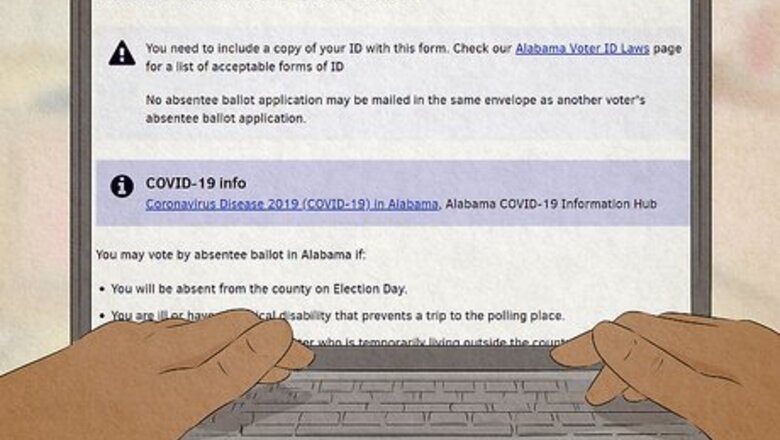
views
- Apply for an absentee ballot with your local election office or online to get one in the mail.
- If you live in CA, CO, D.C., HI, NV, OR, UT, VT (general elections only), or WA, you'll automatically get a ballot in the mail if you're registered to vote.
- Use the Federal Post Card Application (FPCA) to request an absentee ballot if you're a US citizen who currently lives in another country.
Requesting a Ballot in the US
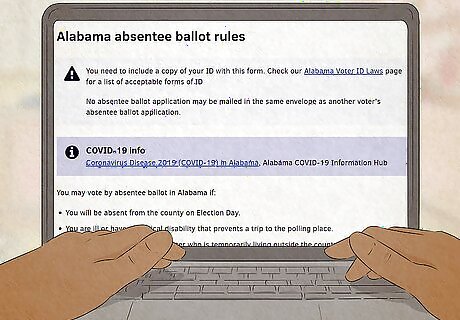
Check your state's eligibility requirements online. In 8 states—California, Colorado, Hawaii, Nevada, Oregon, Utah, Vermont (general elections only), and Washington, plus D.C.—elections are conducted entirely by mail. You don't have to request a ballot if you live in one of these locations. In 27 states, you don't need an excuse to vote absentee—all you have to do is request a ballot. And in 15 states plus American Samoa, Guam, the Northern Mariana Islands, Puerto Rico, and the US Virgin Islands only allow people to vote absentee if they have a valid reason that they won't be able to vote in person during the early voting period or on Election Day. New York will become the newest state to offer no-excuse absentee voting starting January 1, 2024. You'll likely have a valid excuse if you're going to be out of your state or county on Election Day and during the early voting period or if you have an illness or disability that prevents you from voting in person.
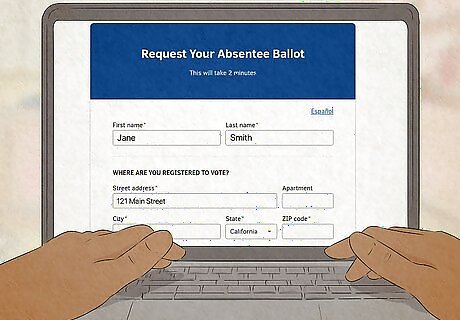
Fill out an absentee ballot application online. As long as you meet your state's conditions for voting absentee (if there are any), you'll get an absentee ballot in the mail—but you have to request one first! The online application portal makes it easy to do this. And if the process is unable to be done entirely over the Internet, all you have to do is print off your completed application, sign it, and stick it in the mail. In some states, such as Alabama, you must make a copy of the front and back of your state-issued driver's license or ID card and include that with your ballot. If you are blind or visually impaired, note on your application that you need an accessible ballot.
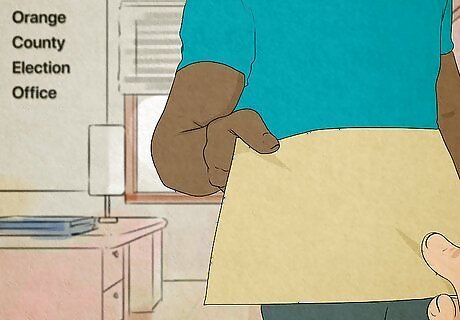
Mail your application before your state's absentee ballot application deadline. If it's getting close to the deadline, you might want to take your application to your local election office in person instead of mailing it there. That way, you can be certain that you'll get an absentee ballot and have the chance to vote. Some states have a postmark deadline, while other states have a "received by" deadline. Be sure you check your state's deadline type so you're not late. Depending on when you send in your application, start looking for your ballot around a month before Election Day. If it's a week before Election Day and you still haven't received an absentee ballot, contact your local election office.

Fill out and return your completed ballot as soon as you get it in the mail. Most states require ballots to be received before the polls close on Election Day. Depending on the date you received it, you might not have much time! So go ahead and fill it out and get it sent in as soon as you can. If your ballot doesn't come with a self-addressed envelope, mail it to the address listed on the ballot itself. Some states only require your ballot to be postmarked before Election Day. Your ballot will still be counted as long as it gets there within a couple of weeks of Election Day. Some states, such as North Carolina, require you to sign your ballot in the presence of a witness or notary, who must also sign the envelope. Your state might have drop-off boxes you can use if you don't want to stick your ballot in the mail. Check with your local election office or look at the instructions included with your ballot. If your state has a ballot tracker, you can use that to confirm your ballot was received and your vote was counted.
Requesting a Ballot from Abroad

Determine your voting residence. Typically, your voting residence is the same as your legal residence. Simply put, it's the place where you last lived before you left the US. It doesn't change, even if you no longer own that property. If you were born outside the US and have never lived in the country, you might not be able to vote—even though you're a US citizen. Check the rules in the last state where your parent or guardian lived.
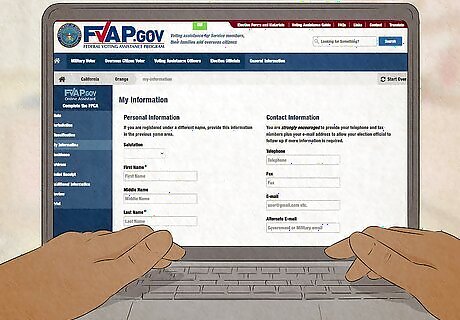
Fill out the Federal Post Card Application (FPCA). With the FPCA, you can both register and request an absentee ballot using the same form. Even better, using the FPCA requires your state to send your absentee ballot at least 45 days before the next election. That gives you plenty of time to cast your vote and send it back so your voice can be heard.
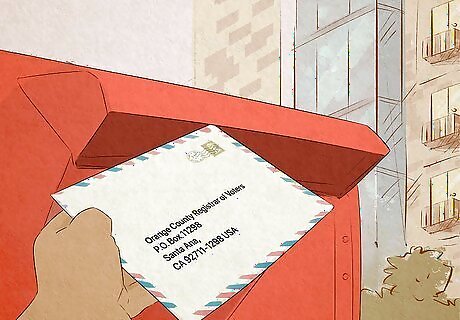
Mail your FPCA to the election office in your voting residence. While you can fill out the FPCA online, you can't submit it digitally. Print it out and sign it, then mail it to the local election office listed for your voting residence. If you're blind or visually impaired, make a note in the "additional information" box that you need an accessible ballot.
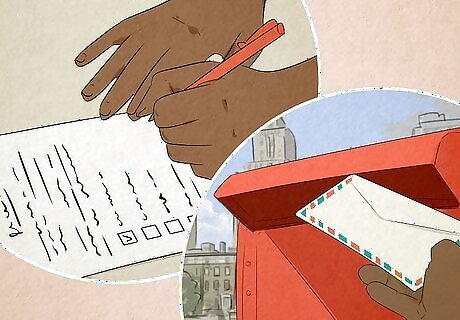
Complete and mail your ballot back as soon as you get it. Your local election office mails your absentee ballot to the address you provided on your FPCA. Check your state's deadline to make sure you get it out in time for your vote to be counted. Many states also have ballot trackers if you want to make sure your ballot was received and counted.
Before You Vote Absentee: Confirming or Updating Your Registration
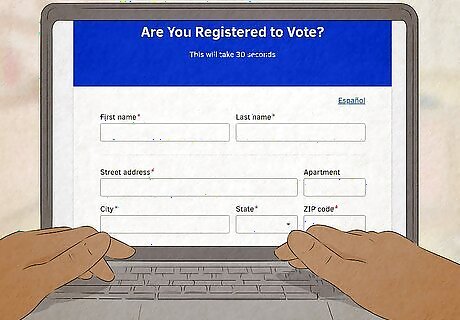
Look up your voter registration online. Not sure if you're registered or if your registration information is correct? It only takes about a minute to check your information online. If you see anything that's wrong, update your registration before you request an absentee ballot or attempt to vote in person. You might not be allowed to vote if your registration doesn't match the information on your state-issued driver's license or photo ID. North Dakota is the only state where you're not required to register to vote.
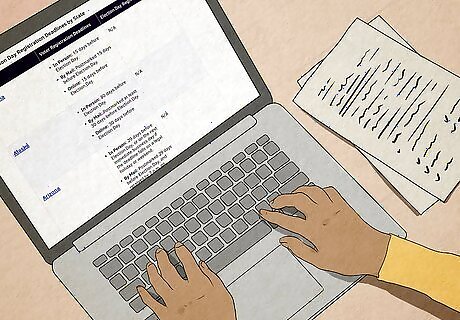
Check your state's registration deadline online. Some states have registration deadlines up to 30 days before Election Day, while others allow you to register all the way up to Election Day. If you plan to request an absentee ballot, compare the registration deadline to the deadline to request an absentee ballot. Make sure you're leaving yourself enough time!

Use the online application to change any incorrect information. To update your information, use the same form you would use to register to vote for the first time. There are additional boxes to fill out if you need to change your name or address. Only 9 states don't have online voter registration: Arkansas, Maine (currently in the process of implementing online registration), Mississippi, Montana, New Hampshire, North Dakota (no voter registration), South Dakota, Texas, and Wyoming. If you live in one of those states, register or update your registration by mail or in person. You can still fill out the form online to save some time. Your state might allow you to request an absentee ballot at the same time you submit your voter registration—just look for a box on the application that you can check to do this.
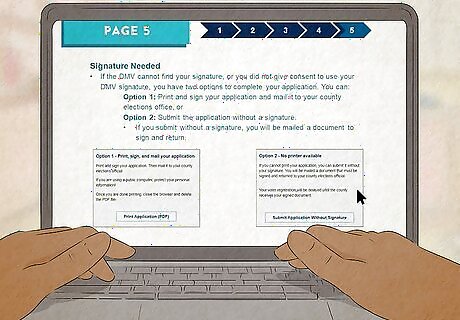
Submit your updated information to your state's election office. If you're registering online, simply click the button to submit your application. If you provided an email address, you'll get an email confirmation that your application was received. It might take a few days or even weeks before your application is processed—especially if you're getting close to your state's deadline.

Confirm online that your registration was updated. Give the election office a few days or a week to process your registration application, then check your registration status. If the information hasn't been changed, contact your local election office to ask about it.


















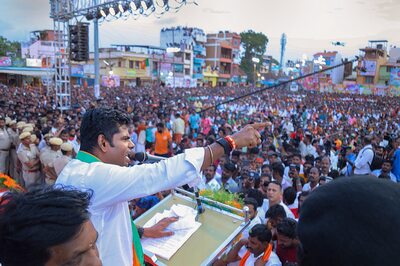

Comments
0 comment